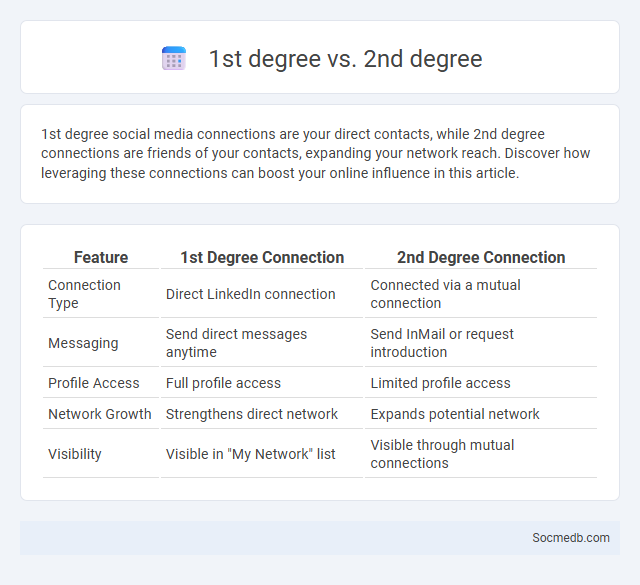
Photo illustration: 1st degree vs 2nd degree
1st degree social media connections are your direct contacts, while 2nd degree connections are friends of your contacts, expanding your network reach. Discover how leveraging these connections can boost your online influence in this article.
Table of Comparison
| Feature | 1st Degree Connection | 2nd Degree Connection |
|---|---|---|
| Connection Type | Direct LinkedIn connection | Connected via a mutual connection |
| Messaging | Send direct messages anytime | Send InMail or request introduction |
| Profile Access | Full profile access | Limited profile access |
| Network Growth | Strengthens direct network | Expands potential network |
| Visibility | Visible in "My Network" list | Visible through mutual connections |
Understanding Degree of Connection: An Overview
Understanding the degree of connection on social media involves analyzing the strength and frequency of interactions between users, which helps in identifying close relationships and influential networks. Metrics such as engagement rates, comment frequency, and message exchanges provide valuable insights into how deeply connected Your audience is with your content or brand. Leveraging these insights enables more targeted communication strategies and fosters meaningful online communities.
What Is a 1st Degree Connection?
A 1st degree connection on social media refers to a direct relationship between you and another user, meaning you are connected without intermediaries. This level of connection allows immediate messaging and sharing of content, enhancing your networking opportunities. Understanding your 1st degree connections is crucial to leveraging personal and professional relationships effectively on platforms like LinkedIn.
Key Features of 2nd Degree Connections
2nd degree connections on social media expand Your network by linking you to friends of friends, increasing opportunities for professional collaboration and information sharing. These connections often provide valuable insights into new industries, potential job leads, and mutual acquaintances. Leveraging 2nd degree connections enhances visibility and trustworthiness within Your social or professional circles.
Defining Connection Degree in Networking Platforms
Defining connection degree in networking platforms involves measuring the number of direct links between users, commonly labeled as first-degree, second-degree, and third-degree connections. First-degree connections refer to direct contacts, while second-degree connections represent friends of those contacts, expanding the network reach and potential engagement. Understanding connection degrees enhances targeted communication strategies and helps optimize social media algorithms for personalized content delivery.
Differences Between 1st and 2nd Degree Connections
First-degree connections on social media are your direct contacts, allowing for immediate interaction and message exchange, while second-degree connections are friends of your friends, expanding your network without direct communication privileges. Your engagement with first-degree connections often yields higher trust and responsiveness compared to second-degree links, which primarily serve as potential new contacts or leads. Understanding these differences helps optimize your social media strategy for meaningful interactions and network growth.
The Role of Mutual Connections in Networking
Mutual connections play a crucial role in social media networking by bridging trust and credibility between You and new contacts. Leveraging these shared relationships can significantly increase the chances of successful introductions and meaningful collaborations. Platforms like LinkedIn emphasize mutual connections to help expand Your professional network efficiently and authentically.
How Connection Degree Impacts Professional Networking
Connection degree significantly influences professional networking by determining the reach and strength of an individual's network. First-degree connections provide direct access to trusted contacts, while second- and third-degree connections expand opportunities for introductions and collaborations. Leveraging higher-degree connections increases visibility in industry circles and enhances career growth potential through diverse resource sharing.
Strategies to Leverage Connection Degrees
Understanding and leveraging your social media connection degrees can dramatically expand your reach and influence. By engaging with second-degree connections through shared interests and mutual contacts, you can amplify your content visibility and build trust within targeted networks. Implementing targeted outreach and personalized interactions will optimize Your ability to convert these extended connections into meaningful engagements and opportunities.
Privacy Considerations Across Connection Degrees
Social media platforms implement varying privacy settings based on connection degrees, such as friends, friends of friends, and public users, to control content visibility and data sharing. Users should carefully manage permissions to minimize exposure of personal information to extended networks and unknown users. Privacy policies increasingly emphasize granular controls to help mitigate risks associated with differing levels of social connections.
Using Connection Degrees for Expanding Your Network
Leveraging connection degrees on social media platforms, such as first, second, and third-degree connections, enables strategic network expansion by targeting relevant contacts and mutual acquaintances. Engaging with second-degree connections through shared groups or endorsements increases visibility and fosters trust, leading to higher chances of meaningful interactions. Optimizing this approach enhances professional growth opportunities, brand awareness, and collaborative potential across platforms like LinkedIn and Twitter.
 socmedb.com
socmedb.com